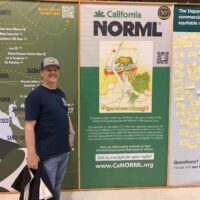
Left to Right: Blanco (labor), Farnsworth (pesticides), Morland (BOE), Woods (DPH), Schultz (water), Tsou (BMCR), Morris (agriculture).
UPDATE: Cannabis was discussed at a CDFA board meeting on August 2. See video.
July 29 – Regulators from seven different state agencies, including the new Bureau of Medical Cannabis Regulation, spoke at a policy workshop sponsored by the California Grower’s Association in Sacramento.
“There are a lot of different strings in this Gordian knot,” said Casey O’Neill, CGA’s president. “Growing up in the hills under the choppers, we never thought we’d be here.”
Amber Morris, Branch Manager of the Medical Cannabis Cultivation Program at the California Department of Food and Agriculture, gave a short history of her department, saying in 2010 the agency refocused on addressing overregulation, water supply, urbanization and climate change. Of the 12 key strategies in the department’s Ag Vision, and given MCRSA’s legislative intent to protect the environment, three strategies apply to the nascent cannabis industry:
– ease the burden of regulations while maintaining health, safety and the environment
– expand environmental stewardship
– promote renewable energy and fossil fuel alternatives
The agency is working on regulations and systems to license cultivators and is also in charge of implementing a track and trace program mandated in state law. Her agency, through a contractor, will be conducting a statewide Environmental Impact Report on cultivation impacts to air and water quality, noise, and other factors. And EIR on this topic is unprecedented since none of the other states that have legalized marijuana are required to follow a law like California’s CEQA.
Asked about some of the large cultivation projects being approved by local governments in the absence of state licensure, Morris said that, “State law will trump local law.”
Morris cited a lack of “knowns” and a tight timeline as challenges to completing the EIR, which usually happens before regulations are written. She said she has visited cultivation sites and is conducting an online survey of cultivators at the department website through August 12. In September, the agency will have a mail listserve up and running and will be hosting workshops in eight locations across California.
An-Chi Tsou, Senior Policy Advisor at the Bureau of Medical Cannabis Regulation in the Department of Consumer Affairs said her department is also conducting a survey and has had 837 responses, but wants more. BMCR is holding weekly meetings with all regulating agencies, and was in Coalinga the previous day as part of a series of workshops the agency is holding across the state.
While knowing California is unique, Tsou said the agency just held a confab with seven Western states to talk about issues like track and trace, pesticides, and safety. She welcomed input on “dream regulations” and invited all to join the agency listserve; scroll down to mail list at www.BMCR.ca.gov
As to local regulations, Tsou’s advice was, if your city or county doesn’t have licensing regulations, ask local elected officials for them to be implemented. Learn about laws in surrounding areas and “Be gentle. Folks are still learning,” she advised.
Dan Shultz, Sr., Environmental Scientist, Cannabis Interim Flow Unit, Div. of Water Rights, State Water Resources Control Board said his office hopes to have interim Principles and Guidelines developed by August, and final regulations published by March 2017 followed by a 60-day comment period. He said the Water Board, will hold outreach meetings late August or September. Shultz asked for input on key locations to hold those workships and recommendations on Principles and Guidelines and said he will soon have a website and email subscription list. Two Regional Water Resources Control Boards, in the North Coast and the Central Valley, have pilot regulatory programs in operation for cannabis farms.
Stephen Woods, Chief, Division of Food, Drug and Radiation Safety, CA Dept of Public Health said his department’s focus is on licensing and regulating manufacturers; they are also helping with 3rd party labs. Woods also plans to announce statewide meetings, and a listserve, and says his office has an open-door policy. He’s got a stack of business cards from industry players who he’s met with, and is also hearing from anti-cannabis interests. Woods said the agency is developing a medical cannabis lab at their Richmond campus. See DPH Office of Medical Cannabis Safety website.
Tim Morland, Legislative Director, Office of Fiona Ma, Chair of the Board of Equalization gave out his phone number (916-323-9444) in case anyone has questions about getting a seller’s permit. He noted that getting a permit does not require listing a cultivation site address, and that growers may qualify for a partial tax exemption for machinery they purchase. His office is also working on the track and trace program, and he said they will ultimately have access to shipping manifests and other means of tracking and taxing cannabis products.
Morland commented that Santa Barbara’s proposed 20% local tax was “way too much….we’ll see if that’s successful. Hopefully not.” He spoke a bit about his auditing methods, like sitting outside a dispensary and counting customers, joking that it might be skewed if the auditor shows up on 4/20.
Morland said the BOE is in favor of AB 567 (Gipson), offering tax amnesty to dispensaries, noting that penalties and fines for back taxes can be more than the taxes themselves, and expressing a desire to relieve cannabusinesses from these. BOE also favors AB 821 and AB 2149 speaking about the difficulties in accepting cash payments. “Cash is still legal tender,” he said, but noted that it took staff six hours to process a $400,000 payment made recently to the San Francisco office. “Do these other agencies (indicating his fellow panelists) want to take cash payments? I don’t think so.”
Banking is by far the biggest issue, Morland said, noting he’s been meeting with the Federal Reserve and bankers. To applause from the crowd, he said the BOE would be getting pro-active in lobbying the Federal government for banking reform in the cannabis industry.
George Farnsworth, Assistant Director, Pesticide Programs Division, CA Dept. of Pesticide Regulation, said that the Federal FIFRA Act prevented his department from establishing safe levels of federally regulated pesticides used on cannabis. His department put out a flyer last year with guidance on the issue; he called it a “living document” and said it has been revised twice.
Farnsworth said his office would be conducting residue risk analyses with DPH to allow them to adopt regulations, and hopes to have those finished by the time licensing begins. He is also developing a website, and will be working with local county ag commissioners, hoping to implement integrated pest management programs. He gave his email address.
Finally, Eduardo Blanco, Special Legal Advisor, Agricultural Labor Relations Board said he is developing educational seminars for the cannabis industry on safe labor practices and legal requirements. He noted that under state law, workers have the right to seek representation by a union, and said that three unions are currently interested in organizing the cultivation work force. At present, all applicants will have to sign a statement identifying them as an agricultural employers, and licensees with 20 or more employees will have to sign a labor peace agreement, allowing for mediation with unions. He also gave his email address.
Many of the panelists noted that their efforts are being “timeline driven.” Normally fast-tracking an industry means taking three years to write regulations, said Woods. “If the initiative (Prop. 64) passes it only gets more expensive and complicated,” Morland said. Morris and Woods both said they are hiring staff to help with the process. (See one posting.)

Taylor Blake from the CGA Distribution and Transportation committee speaks at a breakout session.
The workshop also included an update on legislation from CGA lobbyist Jason Bryant and breakout sessions on: Appellations, Concentrates and Extraction, Distribution and Transportation, Track and Trace Licensure, Compliance for Cultivators, and Water Quality Monitoring & Watershed Management. Probably the best idea I heard all day was in the Water session, where someone suggested organizing Appellations by watershed, giving growers an interest in keeping their watershed healthy.
At the end of the day Dennis Hunter from the CBD Guild and Mai Vue representing California’s Hmong growers told their stories. The Hmong have been targeted in several counties for garden raids, and voter fraud has allegedly been committed against the community in Siskiyou and Trinity counties.
CGA’s new Director of Community Development and Local Engagement Susan Riggs wrapped up the day with some some great tips on local activism at this critical time. Some of them were:
– If you’re not at the table you’re on the menu
– If you’re not part of solution you’re part of the problem.
– Walk in with solutions instead of complaints
– Stakeholders make the best advocates. Lawmakers need to see who we are: intelligent, attractive, passionate people
– A house divided against itself cannot stand: get in a room with other advocates and come up with a common platform.
– Support helpful officials, write checks and volunteer.
– Be involved in your community.
– Be patient, don’t get discouraged, and remember sometimes you must lose a battle to win a war.
– Take the long view and stay engaged even after your locals take action.
There will be no rest for activists as five marijuana regulation bills will be heard in the Senate Appropriations committee on Monday, August 1, and CDFA will host an update on cannabis regulations and GMOs on Tuesday the 2nd, a day on which CGA members in their green “I am a farmer” T-shirts are expected to be seen at the Capitol.
(Side note: Morris saw my Cal NORML name tag on her way in and told me, “We’ve been on your website a lot.” However, someone from another agency told me that he is blocked from visiting our site, but is working with his IT department to remove the block. Many other attendees told me they regularly visit the Cal NORML site. If you find our site valuable, please become a member and support our work.)



